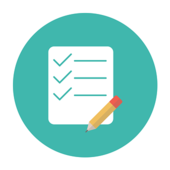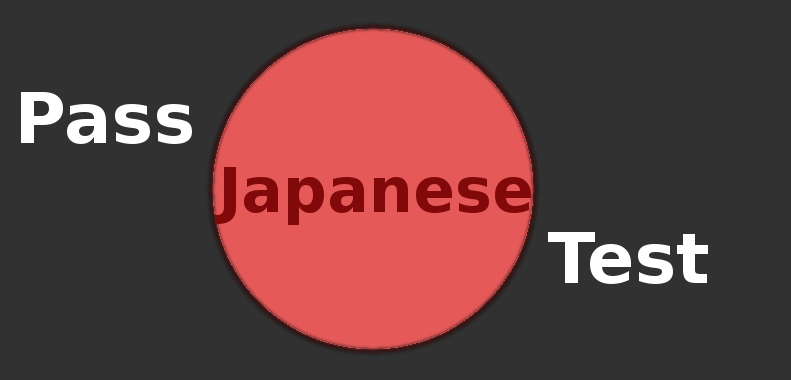Read the official website and still don’t understand the JLPT format? I’ll give an easily understood description of each JLPT section.
The test consist of 4 major focus areas: vocabulary, grammar, reading, and listening. Each area is further segmented into by question type. After reading the official page most people are still left with a “Huh? So what kind of questions can I expect?” I’ll give an easy to understand explanation below. Of course you should also see (and use for practice) the sample questions provided on the official website.
The N3-N5 levels have 3 timed sections: vocabulary, grammar + reading, and listening. The N1-N2 levels consist of 2 timed sections: vocabulary + grammar + reading and listening. This provides more flexibility in how you use you time during the N1-N2, but means that you need to manage your time well.
JLPT Format

Vocabulary
There are usually a handful of questions for each type listed below.
- Kanji Reading: Choose the reading for the underlined kanji.
- Orthography: (N2-N5 only) Choose the kanji for the underlined word written in hiragana.
- Word Formation: (N2 only) Fill in the blank where the blank is half a word. You usually end up creating a 3-5 character kanji word.
- Contextually Defined Expressions: You’re given a sentence and asked to fill in the missing word. Usually more than one word will fit grammatically so you need to use the context of the sentence to choose the best answer.
- Paraphrases: Choose the word or phrase that best replaces (with the same meaning) the underlined one.
- Usage: Choose the sentence that uses the given word most correctly.
Grammar
Similar to the Vocabulary section, each of the following types has around 5 questions.
- Selecting Grammar Form: You’re given a sentence and need to fill in the blank by choosing a grammar form.
- Sentence Composition: Here you get a sentence with a few consecutive blanks. Each blank represents a word/phrase. You need to put them in the correct order.
- Text Grammar: Many questions linked to a single passage. The passage has a series of blanks and you must choose the correct grammatical phrase for each blank
Reading
This section of the test is 100% reading comprehension. That means you read a passage and answer questions about it. Below I explain the different question types you will encounter.
- Comprehension (short, medium, long): Most of the reading questions fall into this category. You read a passage and answer questions based on the reading. There are many passages some with only one question and some with multiple questions. Some passages are long (1000 words) while others are short (200 words). The length and difficulty of passages scales with the level of JLPT.
- Information Retrieval: You are given some type of figure in Japanese and asked questions about it. In the old version of the JLPT this was always a graph/chart of some kind. The new tests I have seen or taken all feature some type of advertisement or notice…something you would typically see posted on the wall at a store or your apartment complex.
- Integrated Comprehension: (N1-N2 only) There is typically one passage in the reading section that is a combination of two smaller passages (A and B). You are usually asked a few questions about similarities and differences between the opinions expressed in A vs B.
- Thematic Comprehension: (N1-N2 only) You read a long passage and answer question(s) about the overall meaning. Reading this passage in detail is a waste of time, so you should try to skim it, answer the question, and move on.
See reading strategies to help you in the reading section.
Listening

In this JLPT section the questions come at you rapid fire one after another, whether you are ready to move on or not. It is important that you focus on the current question. Even if you are unsure of the correct answer, when the next question starts, bubble in an answer and move on.
- Task-Based Comprehension: You are given the description of the situation and asked a question about the conversation that follows. You then listen to the conversation (usually between two people) and are asked the question again. You choose from the answers written on the page.
- Comprehension Of Key Points: The flow of this question type is the same as the Task-Based Comprehension. The difference here is that the conversation is usually a bit longer and the question tests your ability to pull out a small detail.
- Comprehension Of General Outline: (N1-N3 only) This type of question can be rather challenging. Here you get only a description up front. They ask a question about the general meaning of a rather long conversation or monologue. The answers you choose from are then spoken; the answers do NOT appear on the question sheet.
- Verbal Expressions: (N3-N5 only) These questions are fairly quick. You get a picture of a situation where an arrow is pointing to one person. Choose the phrase that the person with the floating arrow should say. Again, the answers you choose from are spoken and do not appear on the question sheet.
- Quick Response: As the name implies, this is the fastest type of question. One person says a sentence. You choose the most appropriate response. Again the answers are only spoken. Some of the responses can sound somewhat ridiculous and sometimes you hear chuckling in the test room. Use these free hints to your advantage.
- Integrated Comprehension: (N1-N2 only) These conversations are long and there are multiple questions per conversation. The questions only come after the conversation and you choose from answers written on the page. Since you can see the answers before hand, you can usually guess what the question will be. I recommend you take notes during the conversation to help yourself when it comes time to answer the questions.
See listening strategies to help you in the listening section.
Checkout the rest of the JLPT Playbook
